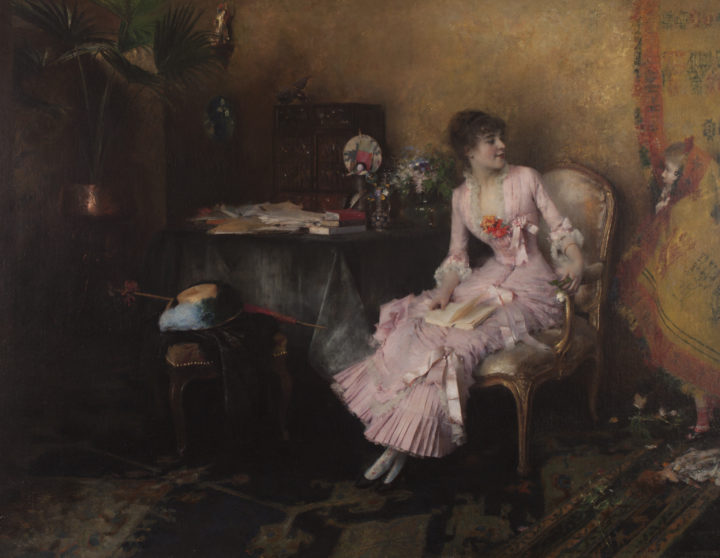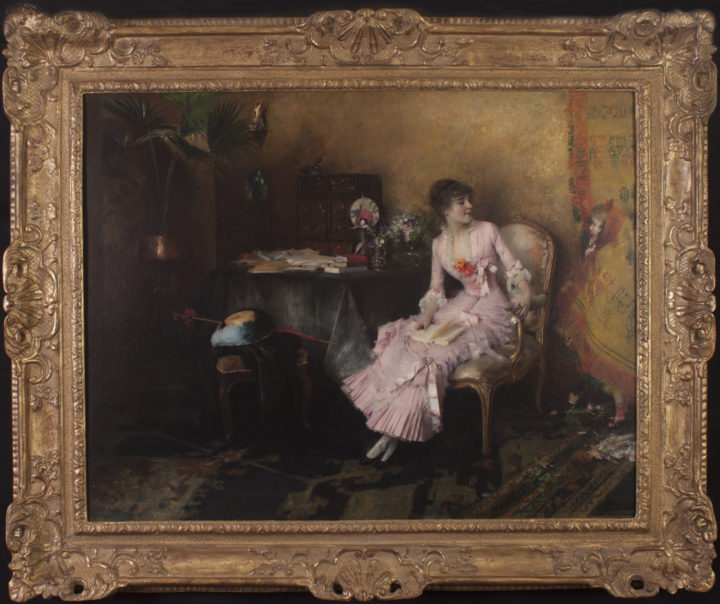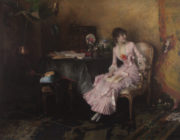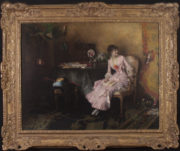Hide-and-Seek (Cache-Cache)
French (1852-1929)
Hide-and-Seek (Cache-Cache), 1882
Oil on canvas, 25 x 32 inches
Signed, inscribed and dated PAJ Dagnan-B PARIS 1882 lower right
Provenance
The artist
Acquired from the above by Goupil & cie, Paris, June 1882, no. 16193
Acquired from the above by Knoedler & Co., New York, February 1883, no 4325
Acquired from the above by Charles Goddard Weld, Boston, March 1883
Hammer Galleries
Acquired from the above by Mr. Jeffrey and Mrs. Jill Stoff, Wellesley, Massachusetts, circa 1940
Literature
J. Dampt, Andre-Charles Coppierm Catalouge des Oeuvres de M. Dagnan-Bouveret, Peintures, Paris, 1930, Librairie du Bulletin de L’Academie des Beaux-Arts, pg. 23 as Jeune demme en rose avec son enfant.
Essay
In the early 1880s, Dagnan-Bouveret turned his attention away from traditional Salon subject matter and instead focused on scenes from contemporary society as popularized by the novels of Emile Zola and Alphonse Daudet. Dagnan-Bouveret’s genre scenes found a ready market in Europe and especially in America and Cache-Cache was the sort of painting that had immense appeal. As a dedicated chronicler of both modern and fashionable Paris, Dagnan-Bouveret’s paintings from the early 1880s often depict scenes set in well-appointed Paris interiors. These settings, with their abundance of objects made with varied textures and colors, allowed him to showcase his technical virtuosity learned earlier in the studio of Jean Léon Gérôme.
Cache-Cache is a snapshot of its time and represents an inside view of upper-class life in the last decades of the 19th century in Paris. Dagnan-Bouveret pretty much abandoned this subject matter after the early 1880s. He replaced it with themes from peasant life in the spirit of Jules Bastien Lepage, which he followed with an almost mystical interpretation of scenes from the life of Christ and the Blessed Virgin Mary. In our painting, the two models play a game of hide-and-seek. The unposed casualness of the scene – almost like a snapshot – suggests Dagnan-Bouveret’s early explorations into the use of photography and how it could be translated into painting. Of equal importance to the two figures is the opulent interior of the room with all of its fittings; the space overflows with decorative details, silk and velvet fabrics, a copper pot, an oriental rug and a gilt chair. Through the various objects on the table and mounted on the wall, the painting also illustrates Dagnan-Bouveret’s fascination with Japanese and exotic knick-knacks, a passion he shared with James McNeill Whistler, and many of his contemporaries, like Alfred Stevens and Claude Monet. In fact, Japonism became an integral part of upper-class interiors after Japanese ports reopened to Western trade in 1854 following 200 years of closure. The world fairs in London in 1862 and in Paris in 1867, where Japan showed its art and objects for the first time, were especially instrumental in developing the vogue for all things Japanese. Interestingly, the first private owner of Cache-Cachewas the Boston collector, Charles Goddard Weld (1857-1911). In 1886, Weld purchased the esteemed Ernest Francisco Fenollosa collection of Japanese art, bequeathing it together with his own personal holdings of Japanese art to the Museum of Fine Arts in Boston. This generous gift contributed to the museum becoming known for the most extensive collection of Japanese art outside of Japan.




